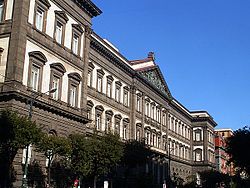- University of Naples Federico II
-
University of Naples Federico II Università degli Studi di Napoli Federico II 
Motto Ad Scientiarum Haustum et Seminarium Doctrinarum Established 1224 Type State-supported Rector professor Massimo Marrelli Admin. staff 4535 (2006) Students 96867 (2010) Location Naples, Italy Sports teams CUS Napoli Affiliations UNIMED Website www.unina.it/ The University of Naples Federico II (Italian: Università degli Studi di Napoli Federico II) is a university located in Naples, Italy. It was founded in 1224 and is organized into 13 faculties. It is the world's oldest state university[1] and one of the oldest academic institutions in continuous operation. The university is named after its founder Frederick II.
Contents
History
The University of Naples Federico II was founded by emperor of the Holy Roman Empire Frederick II on 5 June 1224. It is the most ancient institution state-supported of higher education and research in the world. One of the most famous students of this university was Roman Catholic theologian and philosopher Thomas Aquinas.
Political Project of Fredrick II
Fredrick II had a precise political project when he stated to found the university in Naples: first, to train administrative and bureaucracy skilled professionals for the "curia regis" (the kingdom ministries and governance apparatus), also it was necessary to prepare lawyers and judges who would help the sovereign in order to draft laws and executing justice; secondly he wanted to facilitate the promising young students and scholars in their cultural formation, avoiding their unnecessary and expensive trips abroad (that is also more pragmatically to say that by creating a State University, emperor Frederick avoided that young students of his reign will complete their trainining at University of Bologna which was a city hostile to the imperial power).[2][3][4]
The University of Naples was arguably the first to be formed from scratch by a higher authority, rather than upon an already-existing private school. Although its claim to be the first state-sponsored university can be challenged by Palencia (which was founded by the Castilian monarch c.1212), Naples was certainly the first chartered one.[5]
The artificiality of its creation posed great difficulties in attracting students (Thomas Aquinas was one of the few who came in these early years). The university's early years were further complicated by the long existence, in nearby Salerno of Europe's most prestigious medical faculty, the Schola Medica Salernitana. The fledgling faculty of medicine at Naples had little hope to compete with it, and in 1231, the right of examination was surrendered to Salerno. The establishment of new faculties of theology and law under papal sponsorship in Rome in 1245 further drained Naples of students, as Rome was a more attractive location. In an effort to revitalize the dwindling university, in 1253, all the remaining schools of the university of Naples moved to Salerno, in the hope of creating a single viable university for the south.[6] But that experiment failed and the university (minus medicine) moved back to Naples in 1258 (in some readings, Naples was "refounded" in 1258 by Manfred Hohenstaufen, as by this time there were hardly any students left). The Angevin reforms after 1266 and the subsequent decline of Salerno gave the University of Naples a new lease on life and put it on a stable, sustainable track.[5]
Organization
The university is divided into 13 faculties:
- Agriculture
- Architecture
- Biotechnology
- Economics
- Engineering
- Law
- Letters and Philosophy
- Mathematical, Physical and Natural Sciences
- Medicine and Surgery
- Pharmacy
- Political Sciences
- Sociology
- Veterinary Medicine
Notable alumni
- Giorgio Napolitano, current President of the Italian Republic.
- Nicola Abbagnano, philosopher.
- Gaetano Filangieri, jurist and philosopher.
- Saint Alphonsus Liguori, Doctor of the Catholic Church.
- Renato Caccioppoli, mathematician.
- Fabrizio Freda, current President & CEO of Estée Lauder Companies.
- Fabrizio de Miranda, structural engineer.
- Giuseppe Moscati, Roman Catholic saint, physician, educator, and scientist
- Fulvio Tessitore, philosopher.
- Francesco De Martino, eminent jurist, intellectual and politician.
- Ettore Majorana, physicist.
- Saint Thomas Aquinas, philosopher and theologian.
- Giambattista Vico, philosopher, historian, and jurist.
- Umberto Nobile, aeronautical engineer and Arctic explorer.
- Antonio Labriola, philosopher.
- Giorgio Orofino, Entrepreneur.
- Roberto Saviano, journalist and novelist.
Notable professors
- Macedonio Melloni, physicst
- Giuseppe Mercalli, volcanologist
- Filippo Silvestri, entomologist
- Renato Caccioppoli, mathematician
See also
- ESDP-Network
- List of Italian universities
- List of medieval universities
- Naples
- Botanical Garden of Naples
- Orto Botanico di Portici
References
- ^ Ph.D International Scholarship Resources
- ^ Ovidio Capitani. Storia d'Italia. vol. 4. Turin: UTET. pp. 122.
- ^ "Cenni storici". unina.it. http://www.unina.it/ateneo/cenni/index.jsp. Retrieved 15 maggio 2011.
- ^ Norbert Kamp. "Federico II di Svevia". Treccani.it. http://www.treccani.it/Portale/elements/categoriesItems.jsp?pathFile=/sites/default/BancaDati/Federiciana/VOL01/FEDERICIANA_VOL01_000205.xml. Retrieved 15 maggio 2011.
- ^ a b Hastings Rashdall The Universities of Europe in the Middle Ages, Vol. 2 p.22ff.
- ^ C.A. Briggs (1916) History of the Study of Theology, vol. II, p.48
External links
- (Italian) University of Naples Federico II Website
Mediterranean Universities Union (UNIMED) Africa Algeria Egypt Libya Morocco Tunisia Europe Albania Cyprus Finland France Greece Italy Bari · Bologna · Camerino · Catania · Messina · Modena · Molise · Naples 2nd · Naples Federico II · Padua · Palermo · Perugia · Perugia Foreigners · Reggio Calabria · Roma Tre · Rome la Sapienza · Rome S. Pio V · Salento · Sassari · Teramo · Turin · UrbinoMalta Montenegro Portugal Slovenia Spain Western Asia Israel Jordan Lebanon Lebanese University · Saint-Esprit de KaslikPalestinian territories Syria
Categories:- University of Naples Federico II
- Universities in Italy
- 1224 establishments
- Educational institutions established in the 13th century
- Education in Naples
- Buildings and structures in Naples
Wikimedia Foundation. 2010.

